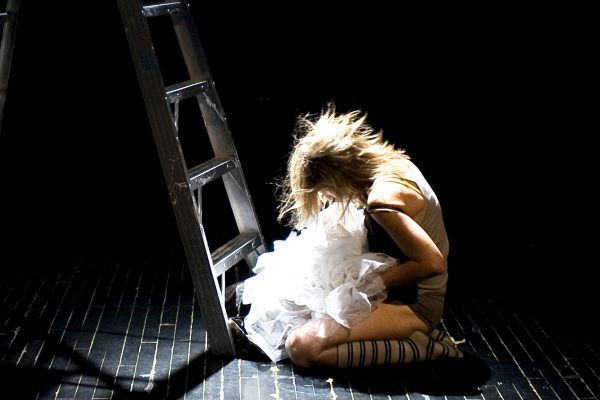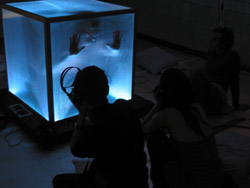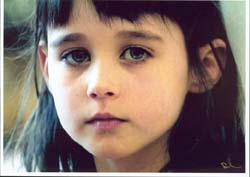It all began from a fascination with pioneering visual artist Betty Goodwin’s “Swimmers” series from the 1980s. From this source, in which Goodwin drew, using graphite, charcoal and oil pastels, on a kind of translucent paper, dancer-choreographer Marie-Josée Chartier conceived a multi-disciplinary mega-production, “Bas reliefs: un dyptique”. The work was co-produced by Montréal’s Danse Cité, and presented in the Traces-interprètes series in December 2006. Personally, I vividly remember walking into a gallery and seeing how Goodwin’s swimmers seemed caught in motion. I recall being astonished at the possibility that these figures were either drowning or perhaps desperately trying to stay afloat — or was it that they were just motionless? There is something intensely poetic about these solitary souls in passage and the theme of mortality that seems to envelope Goodwin’s images.
It’s not hard to imagine that the Toronto-based dance artist with Montréal roots was stoked by similar memories of Goodwin’s work. In fact, I remember speaking to Chartier some years ago when she described how she constructs a piece of choreography, how ideas stay in her head for years until she finally makes the work. “Bas-reliefs” is stirred by visual art and contemporary music, with sets and media elements playing a big part as well. Composed of two pieces without intermission (titled “Premier tableau” and “Deuxième tableau”), the project involved artists from Toronto and Montréal (and at the opening night curtain call, many of those contributing took their bows). Chartier’s choreographers — theatre and opera director Guillaume Bernardi and dance artist Ginette Laurin — were, she says, influenced by water (another obvious strand in Goodwin’s work). A diving board, built into the set, serves in both sections as an upstage reference.
In visual art, bas-relief literally means low contrast. The term describes a form of sculpture that is presented as a painting, in which three-dimensional figures float out from a two-dimensional background. What strikes me immediately in “Bas-reliefs” is the perspective of Julie Fox’s immense set, spatially creating depth of field. (She also created the costumes.) Visuals projected on the side and back panels of the stage are utterly beautiful. Developed by filmmaker Peter Mettler and filmmaker-editor-photographer Jeremy Mimnagh, the projected elements transform — colours blend in subtle and entrancing ways, as greys and blacks shift to blues, for example — and continually draw my focus. In the second work, the panels become a virtual aurora borealis. In both pieces, but particularly in the second tableau, lighting designer Lucie Bazzo creates both intimate and dramatic environments, magically building on textures, shadows and mystery. Atmosphere, through the lighting and visual elements, is everything here, and the result is organic, even seductive.
The first part of the evening, by Bernardi, is distinctly ambiguous, developed apparently from a series of improvisations. In the penumbra, we perceive the dancers, prone. After a brief bit of movement upstage, the space illuminates, clinical white walls casting a cold pall on the environment. Performer Dan Wild slips on a full-face mask to become a kind of divine beast character. With her white pointed hood and bare white legs, Chartier looks a bit like a pint-sized Little Red Riding Hood gone awry. He’s a lurking, shuffling, shadowy monster who, with his slow, grand gestures, somehow entrances and then ravishes Chartier.
She shadows him. They play cat and mouse; he pulls her down; they struggle and resist each other. But there are bits that just don’t make much sense: why does Chartier’s character caress the mask, and why, at different intervals, does she put on and take off the cloak, or he the mask? There is a shifting power relationship, a duality at play, and eventually Wild takes on a vulnerable, tragic weight in his body. One of the most striking images in this tableau is of barelegged Chartier being “birthed” from this hulking figure’s loins. Their bond, as a whole, is oddly conceived. Questions about these characters accumulate in a most unsatisfying manner, and never resolve.
The second tableau, by Laurin, is more successful. The celebrated dance-maker offers a kind of precision that echoes some of her early works, in which partnering defined her aesthetic. Wild is wearing a khaki shirt and pants, and here he has a speaking role, which he scripted and performs with an evocative voice. He recollects bountiful summertime memories from childhood — about being in a garden, snipping flowers — and then conveys a powerful reminiscence about a loved one who is dead. Alexander MacSween’s music is urgent and swelling — the sound like a hornet’s nest. Chartier, in an opaque dress with bits of grass poking out, seems to incarnate the dead woman’s essence. The walls shimmer with Mettler and Mimnagh’s videos images. The music too takes on an iridescent quality. There is simplicity to the choreography: an arm extends, then a leg, a spin and the separate entities become one, with unison floor work and partnering set against the insistent rhythms of the score. The movements are layered — the couple embraces, cajoles, supports — conveying a humanity that is welcome, particularly in contrast to the first tableau. The resonance of this connection transports us, but fleetingly.
What remains most striking in “Bas-reliefs” is the sense of the prospect of the project — the co-mingling of artists and art forms. The performances are solid, and the visual elements sparked my sensibilities, but curiously, the two pieces didn’t cohere and that was a disappointment. Perhaps because I felt adrift in Bernardi’s piece, I never fully entered into Laurin’s either. I recall that earlier conversation I had with Chartier some years ago, when she talked about playing with control while in a production and losing herself. “Losing in the good sense,” she said. “Totally absorbed in what I’m doing, traversing the edge and reaching [the] audience in whatever way. I love to feel that.” That’s what I was longing for in “Bas-reliefs”. Chartier and company have a creative opus on their hands, but it turns out to be an unwieldy one they can’t carry.
Tagged: Contemporary, Interdisciplinary, Performance, Montréal , QC



